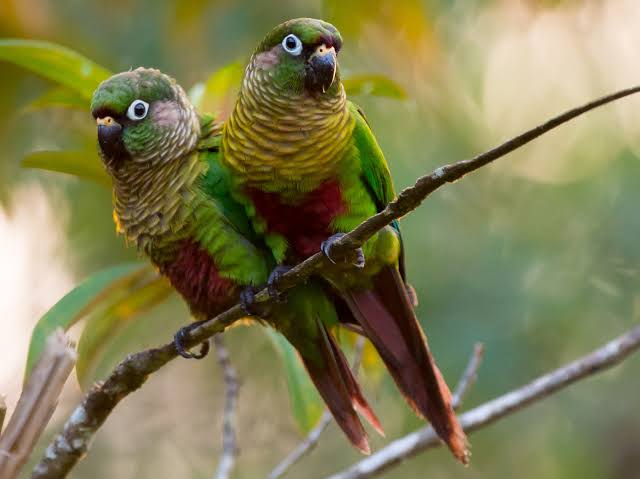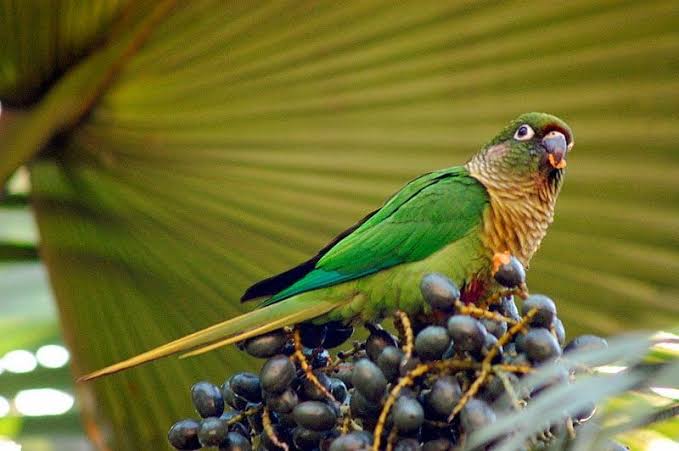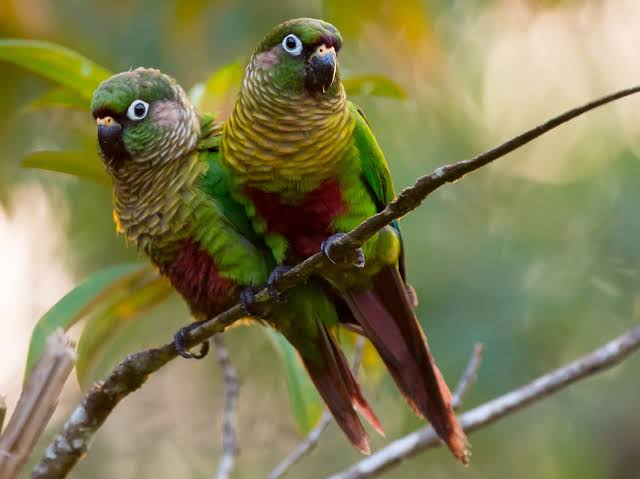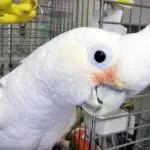Scientific Facts
| Common Name | Maroon-bellied Conure |
| Scientific Name | Pyrrhura frontalis |
| Origin | Northern Argentina, Southeastern Brazil and extended their range up to Argentina, Paraguay, Uruguay, South America and Eastern tip of Bolivia |
| Habitat | Dense forests, local woodlands, and wetland habitats. They are usually seen together in flocks of 12 especially if they are on urban parks or gardens |
| Diet | Fresh vegetables and seeds |
| Size and Weight | 9-10 inches (25 to 28cm) with a weight of about 2.5-3.3 oz (72-94 g) |
| Life Span | Up to15-30 years |
Physical Description

The Maroon-bellied Conure, also known as Maroon-bellied Parakeet, Reddish-bellied Conure, Reddish-bellied Conure, Brown-eared Conure, or Parakeet Scaly-breasted Conure/ Parakeet has a plumage that is mainly green that compliment with its yellow-green scaly front, breast and sides of the neck with brown patches. Its wings have a blue outer web, green-colored inner webs, and color black on the tips. Their tails have a maroon coloration underneath with green colorations on the top part. They are characterized to have cute and charming beauty with the subtle colorations in their whole body.
They have a dominantly green coloration that has a light green belly. The texture of their feathers has a scaly appearance. They can be distinguished easily through the undersides of their tail, which is colored purple and blue. They reach their sexual maturity for about 1 to 3 years. The adults have a thin brown and red frontal band with green cheeks, crown, and hindneck. It has brown and olive breast with yellow banding with the brown and red abdomen and color olive tail. The juveniles have duller in color with less abdominal patches and tend to have a shorter tail.
Where it is Seen?
Maroon bellied conure is endemic to Northern Argentina, Southeastern Brazil, and extended their range up to Argentina, Paraguay, Uruguay, South America, and Eastern tip of Bolivia.
Habitat
They cohabitate dense forests, local woodlands, and wetland habitats. They are usually seen together in flocks of 12, especially if they are on urban parks or gardens.
Behavior and Temperament
The maroon bellied conure is considered as the friendliest bird species on the market. They have an affectionate and cuddly personality making them a good choice for a captive pet parrot. They are curious and energetic birds that always have a desire to explore new things. They have quite a shrill voice that may bother those who are sensitive to noise. The noise they make is an indication and expression of excitement.
Diet

In the wild, they usually feed on fresh vegetables and seeds. In captivity, they are given a good quality seed mix.
Size and Weight
The adults may reach an average size of about 9-10 inches (25 to 28cm) with a weight of about 2.5-3.3 oz (72-94 g). A big portion of their size comprises of their long tail.
Life Span
The maroon bellied conure has about 15-30 years of lifespan in captivity whole expect those who stay in the wild has a shortened lifespan due to several reasons such as destruction of their habitat, illegal hunting and they tend to be more stressful that is why they are more prone to diseases in the wild.
Common Disease/Illnesses
1) Overweight parrot
Like other animals and also humans, overweight leads to some sicknesses. This happens when you overfeed your parrot, but there are instances where overweight and obesity are due to nutritional deficiencies. If you will feed your parrot with healthy food at the right amount, this is totally unavoidable. Your parrot will also have a hard time moving if it is overweight. Avoid giving them a sugary and fatty-based diet.
2) Avian Gastric Yeast (AGY) infection (megabacteriosis)
This disease is due to yeast and bacterial infection. When you notice that your parrot has the inability to digest food and it loses weight, there is a possibility that your parrot is infested with this infection; it is hard to detect during the early stages, so you really need to be keen in observing your pet. A sign that your parrot is having a hard time digesting is when their feces has undigested food, and they vomit with mucus.
3) Aspergillus
This is a respiratory illness for parrots, where the fungal infection affects the functioning of the lungs and air sacs. It is usually acquired through damp and dirty environmental conditions where different kinds of bacteria already flourished. As a manifestation, your parrot may show signs of difficulty in breathing with audible wheezing and mucus discharge in their nostrils.
4) Nutritional Deficiencies
When your parrot lacks certain nutritional deficiency, that effects may be visible physically, such as malformation and dullness in the coloration of their feathers, feather loss, and sometimes change in their behavior. Most of the common nutritional deficiency is the Hypocalcaemia or lack of calcium. If a female is infected with Hypocalcemia, its eggs will be affected because it will produce an egg product which has soft shells that can break easily. There are free particular diet plans for parrots to avoid any deficiency.
5) Candida virus (Thrush), or Candidiasis
This is commonly due to yeast infection that directly targets the digestive tract of the parrot. It is highly transmissible to humans. Your parrot’s experiemucuscous discharge, wheezing, colds, and swollen eyes. It can be treated with antibiotics; that is why your parrot needs to be taken into the nearest veterinary.
6) Macaw Wasting Syndrome, or Proventricular Dilatation syndrome
This disease targets the stomach that will have difficulty in digesting the food that leads to weight loss. Their droppings have undigested food ad evidence. This is fatal if not attended to immediately.
7) Polyoma
The common symptoms of this disease to birds include paralysis, tremors, hemorrhages, lethargic, and diarrhea. There’s still no cure, medication, and vaccination to this disease. Therefore, if you’re planning to buy a parrot, make sure that your bird doesn’t have any diseases and start having your pet to have a test to detect easily if your pet has polyoma or is a carrier of polyomavirus. Quarantine and testing can help prevent polyoma from entering a breeding area.
8) Psittacine Beak and Feather Disease (PBFD)
This is what happens when the immune system of the parrot is low that it can no longer protect its body from different damaging environmental factors. It is not fatal, but it would affect the overall beauty of the parrot and other people who would see that they would perceive that they have a transmittable disease affecting the way how they are handled. There are ointments prescribed to avoid the feather to further drop because feathers are the number 1 barrier against infections.
9) Parrot Fever, or Psittacosis
This is considered as the worst disease or illness a parrot can get because once it strikes, it may spread quickly and may cause affected parrots to die. The bacteria responsible for this is a fatal disease is the Chlamydophila psittaci. It should be treated immediately through the use of antibiotics.
10) Ulcerative dermatitis
This is a disease that brings irritability to the parrot. The bacteria and fungi cause the skin to have wounds and breakage. The parrot feels itchiness and stinging sensations; that is why they further peck their skin, worsening their skin’s condition. When you see that your parrot has an open wound, make sure to do first aid so that it won’t be infected.
Preventing Disease/Illnesses
One of the causes, why parrots are infested with diseases and illnesses caused by bacteria and fungi is due to unsanitary housing. It is not only important to clean their housing, but you also need to clean all the things that it’s in there, such as their substrate, toys, water, and food bowl. In cleaning their cage, make sure not to use disinfectant used in household chores because it contains harmful chemicals that may affect your bird badly, instead make use of disinfectants primary used in cleaning animal cages.
When it comes to their food, make sure not to give your parrot a spoiled food so as to avoid digestive problems. If, in any case, there are some leftovers in their bowl, remove it immediately. especially if it has been in there for how many hours. Another way to avoid diseases or illnesses is to let your parrot have a regular check-up where the veterinarian would conduct a series of tests to know the future health conditions that your parrot will experience so that you can make ways on how to avoid it.
Captive Breeding
These parrot species are not complicated to take good care of as long as you provide their basic needs, such as a big cage where they can roam around, healthy food, and clean water. They are a popular pet to be taken in captivity due to their availability, affordability, nice looks, and silly personality. They may be considered as a hardy bird species. but you’re still obliged to provide for their basic needs. You must devote your time and patience to be a responsible bird owner.
Availability-Where to Get One
Since they are not marked as an endangered species or since there is no threat to their population, you can easily spot them in different pet shops, but they are quite pricey. They are also a common bird species that are being taken cared of bird collectors where they also breed their own.
How to Care Parrot as a Pet

1) Handling
Maroon bellied conure is used to roaming around a wide area, especially if they were taken directly from the wild; that is why in captivity, it should also be given spacious housing where it can play, rest. and sleep. The cage would depend on the size of the bird, a small parrot can stay in a cage with dimensions of 24″ W x 24″ H x 24″ D while larger parrots can stay at around 5” W x 6” H x 3½” ft D. In choosing for the appropriate cage, you must choose a square-shaped or rectangular-shaped cage because if a round-shaped caged were used, there is a possibility that the bird will be aggressive and feel unsafe. They can surpass their aggressiveness when they see people, so avoid placing them in isolation.
2) Temperature
Maroon bellied conure tolerates a room temperature with at least 65 to 85 degrees Fahrenheit. They can stay, whether indoor or outdoors, but when you plan to place it outdoors, make sure that the season is ideal such as in the summer and spring season. Never leave them alone outdoors with a temperature of at least 40 degrees Fahrenheit because it can lead to fatality due to hypothermia. Since the temperature outside is uncontrollable, you may need to invest in a thermostat to improve temperature, especially during the winter season, or you can just transfer the cage in a room with sufficient air circulation.
3) Feeding
Parrot experts suggest giving your pet varying or shifting diet to also get nutrients from other food sources. You can give them pelleted food as well as fresh fruits such as grapes, carrots, berries, bananas, apples, and cooked food pieces like mashed squash, green beans, peas, etc. There are also some foods to avoid, such as caffeine, chocolate, avocado, onions, raw, and dry beans, because these are a poison to them that may cause sudden death. Baby parrots and adult parrots have a different eating pattern; the young tend to be given food more often because they have a fast metabolism while adults are given food in a monitored manner to avoid obesity and other health conditions due to overweight.
4) Water
There are some practices that encourage adding supplements or vitamins to the parrot’s water to increase their nutritional uptake, but this practice is not advisable because the incorporated supplements or vitamins are just wasted since parrots are not an avid water drinker. It is better to give them supplements through their food.
Conservation Status
Their population is stable in the wild; that is why they are marked as the least concern. However, their population is further increased in the wild or in captivity through different effective breeding practices.
FAQ Section
Do maroon bellied conures love their owners?
They are highly affectionate; that is why they need someone who will take good care of them and whom will they love in return.
What do conure noises mean?
Maroon bellied conure produces several loud calls, especially if you leave the room, and there is no one available whom they can play with. Other reasons are being excited.
Why do conures bob their heads?
Head bobbing is normal. For males, they do this as a mating dance while bobbing their head up and down while climbing at the highest point of their cage.
Are maroon conures aggressive?
Maroon bellied conures are considered as wild, aggressive animals if they are taken out directly from the wild during the adult years, there are high chances that they can no longer be tamed; that is why it is advisable to get from reputable sources.
How often do conures poop?
Their poop frequency is about 30-40 minutes or once every 50-60 min.
Do conures do better in pairs?
Yes. They can do well in pairs, and if they have started to stay in pairs, they will be stressed, depressed, and sick if their partner is gone, so be sure to always maintain their partnership.



